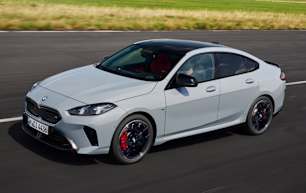Some cars take a few minutes at the wheel before they start to get chatty. Not so the S3. From the moment you grab the lovely leather tiller, haul it into gear and give the perky little turbo-motor a squeeze on the throttle, the Audi is making all the right noises and giving clear, precise feedback on its every move.
Sometimes, cars with lots of tyre, lots of all-wheel drive grip and the sort of sharp steering fitted here, can start to feed back so many responses that it becomes difficult to know which one to respond to.
Not the S3, which seems tuned to a keener driver’s priorities (as it should be, of course). As a result, the steering feedback is distinct from what the rest of the front end is doing and everything else going on is clear, quantifiable and designed to improve the experience.
That even extends to the soundtrack which, Audi told us does not use any electronics to improve it beyond amplifying the engine-bay harmonics which use the windscreen and scuttle as their 'speaker.'
Combined with the active exhaust system, this car honestly sounds like a five-cylinder engine (I opened the bonnet to count the spark plugs to make sure it wasn’t. It isn’t.)
If you’ve ever driven a five-cylinder Audi or a V10-powered R8 (two in-line fives, really) the tune will be a familiar one. Lovely, and – again - such amazing attention to detail.
The 2.0-litre engine runs fairly high boost levels, but that doesn’t seem to have affected the way it storms off the mark. Neither does the dual-clutch transmission contribute any delay, provided you haven’t managed to stand on the brake and throttle at the same time (as many left-foot brakers might).
At that point, the driveline goes into sulk mode and will force you to wait a heartbeat or two before full power is restored. This can be an issue when trying to dart across a busy intersection or merge into a traffic flow.
It’s not a new thing to Audis, but remains an annoyance to those of us who equate having two pedals with having two feet.
The driver-selectable drive modes fitted to the S3 are interesting inasmuch as they actually make a meaningful difference to the way the car operates. They alter the transmission shift points, the throttle sensitivity, steering weight and damper settings.
'Comfort' mode will be the default for most owners, and while 'Dynamic' does sharpen up the dampers ever-so-slightly beyond an acceptable day-to-day level of firmness, it also adds weight to the steering feedback.
Frankly, I don’t think it needs it and simply adding resistance feels like a token gesture. And since the steering has a (non-negotiable) variable rate in the first place, bigger inputs equal a bigger proportionate change of direction anyway.
The damping control is now the more sophisticated magnetic-hydraulic type where hydraulic pressure varies the valving rather than the simpler, previous system of energising an electro-magnet to alter the viscosity of the damping fluid.
This more finite control system has allowed more 'bandwidth' as Audi puts it, between Comfort and Dynamic damper settings.
While the auto mode is almost prescient, it’s not actually pre-emptive but rather takes into account suspension deflection, wheel-speed and driver inputs to come up with a combination of settings to make the most of the situation.
And if you really want to fiddle, you can choose 'Individual' and create an overall setting that combines bits of Comfort and Dynamic with a smattering of 'Efficiency' thrown in.
Toggle down to Dynamic and throw the S3 at some bends and it soon emerges as a pretty gripped-up piece of equipment. The front-drive bias is not really noticeable, but then neither is the transition where the computer begins to engage the rear multi-plate clutch to turn the rear axle into an active participant.
There’s certainly no lack of grip at any stage of a typical corner, and even the odd unexpected damp patch poses no awkward questions. Perhaps the biggest grumble would be the tyre roar at highway speeds, but that’s often the price of performance rubber.












































